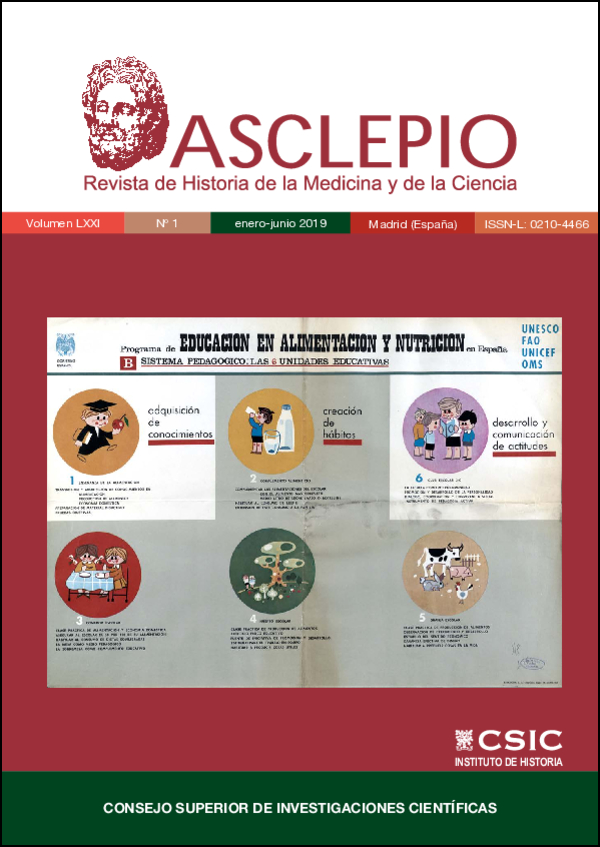Cultures, ethnicities and afflictions. Amerindian Perspectives on Intercultural Health
DOI:
https://doi.org/10.3989/asclepio.2019.11Keywords:
intercultural health, ethnicity, Amerindian peopleAbstract
This article analyzes the incorporation and acknowledgement of the ethnic and cultural variable in the conceptual perspective on Amerindian people’s health, to be considered by institutions such as the World’s Health Organization (WHO) and its American headquarters or Pan American Health Organization (PAHO). Questions such as the concept of person, prevalent ailments and the various uses of ethnical belonging must be considered with flexibility and critical insight in order to avoid monolithic, pigeonholing criteria which detract from the possibilities and benefits that such intercultural perspective can bring to Amerindian people’s access to health.
Downloads
References
Ackerknecht, Erwin H. (1986), Medicina y Antropología Social, Madrid, Akal.
Aguirre Beltrán, Gonzalo (1955), Programas de salud en la situación intercultural. Obra Antropológica V. México, Fondo de Cultura Económica/Universidad Veracruzana/ Instituto Nacional Indigenista / Gobierno del Estado de Veracruz.
Arnold, Denise; Yapita, Juan de Dios; Tito, Margarita (1999), Vocabulario aymara del parto y de la vida reproductiva de las mujeres, La Paz, ILCA.
Bastien, Joseph (1996), La montaña del condor. Metáfora y ritual en un ayllu andino. La Paz, Hisbol,
Berg, Hans van den (1985), Diccionario religioso aymara, Iquitos, CETA-IDEA.
Bernand, Carmen (1986), Enfermedad, daño e ideología, Quito, Abya-yala.
Bertonio, Ludovico (1984), Vocabulario de la lengua aymara, Cochabamba. Ceres/Ifea/Musef.
Campos Navarro, Roberto (comp.) (2009), El empacho en Bolivia (1612-2009), La Paz Prohisaba/Unión Europea.
Clifford, James (1995), Dilemas de la cultura. Barcelona, Gedisa.
Fernández Juárez, Gerardo (2004a), Yatiris y ch'amakanis del Altiplano aymara. Testimonios, sueños y prácticas ceremoniales, Quito, Abya-Yala.
Fernández Juárez, Gerardo (2004b), "Ajayu, animu, kuraji. La enfermedad del "susto" en el Altiplano de Bolivia". En: Fernández Juárez, Gerardo (coord.), Salud e Interculturalidad en América Latina. Perspectivas antropológicas, Quito, Edit. Abya-Yala /UCLM, pp.279-304.
Gutiérrez Estévez, Manuel (2003), "El estilo de la civilización amerindia", Revista de Occidente, 269, pp. 7-24.
Gutiérrez Estévez, Manuel (2010), "Esos cuerpos, esas almas. Una introducción". En: Gutiérrez Estévez, Manuel; Pitarch, Pedro (eds.), Retóricas del cuerpo amerindio. Madrid, Iberoamericana, Madrid, pp. 9-55.
https://doi.org/10.31819/9783954879168-001
Gutiérrez Estévez, Manuel; Surrallés, Alexandre (2015), "Afectividad, cultura y sociedad en pueblos amerindios. Una breve introducción". En: Gutiérrez Estévez, Manuel; Surrallés, Alexandre (eds.), Retórica de los sentimientos. Etnografías amerindias, Madrid, Iberoamericana, pp.9-27.
https://doi.org/10.31819/9783954878352-001
González Saavedra, Luisa (2010), "El cuerpo como referente del universo chayahuita. Se buscan culpables. Aproximación a una teoría de la persona". En: Gutiérrez Estévez; Pitarch, Ramón Pedro (eds.), Retóricas del cuerpo amerindio, Madrid, Iberoamericana, pp.227-253.
https://doi.org/10.31819/9783954879168-008
Holland, William R. (1963), Medicina maya en los Altos de Chiapas, México, Instituto Nacional Indigenista.
Imberton, Gracia (2006), "La vergüenza. Enfermedad y tensiones sociales entre los indígenas choles de Chiapas, México". En: Fernández Juárez, Gerardo (coord.), Salud e Interculturalidad en América Latina. Antropología de la Salud y Crítica Intercultural., Quito, Abya-Yala /UCLM, pp.257-270.
Martínez González, Roberto (2007), "Los enredos del diablo: o de cómo los nahuales se hicieron brujos", Relaciones 111, Vol XXVIII, pp. 189-216.
Martínez González, Roberto (2011), El nagualismo. México, Universidad Nacional Autónoma de México.
Menéndez, Eduardo, (2016), "Interculturalidad en salud. Dudas, limitaciones y repliegues". En: Gil García, Francisco; Vicente Martín, Patricia (coords.), Medicinas y Cuerpos en América Latina. Debates antropológicos desde la salud y la interculturalidad, Quito, Edit. Abya-Yala, pp.53-97.
Meñaca, Arantza (2006), "La "multiculturalidad" de la biomedicina. El envío de medicamentos en familias migrantes ecuatorianas". En: Fernández Juárez, Gerardo (coord.), Salud e Interculturalidad en América Latina, Quito, Edit. Abya-Yala, UCLM, AECI, JCCM, FSCICIII, pp.93-108.
Pitarch, Pedro (1995), Chùlel. Una etnografía de las almas tzeltales. México, Fondo de Cultura Económica.
Pitarch, Pedro (2010), "El problema de los dos cuerpos tzeltales". En, Gutiérrez Estévez; Pitarch, Pedro (eds.), Retóricas del cuerpo amerindio, Madrid, Iberoamericana, Madrid, pp.177-211.
https://doi.org/10.31819/9783954879168-006
Polia, Mario (1989), "Contagio" y "pérdida de la sombra". En: la teoría y práctica del curanderismo andino del Perú Septentrional: Provincias de Ayabaca y Huancabamba. Revista Anthropológica del Departamento de Ciencias Sociales, 7, Lima , Pontificia Universidad Católica del Perú, pp.195?231.
Rivière, Gilles (1982), Sabaya. Structures socio-èconomiques et représentations symboliques dans les Carangas, Bolivie. EHESS, París.
Rubel, Arthur J. (1986 [1966]), "El susto en Hispanoamérica", Arinsana, 1, pp.29?42.
Rubel, Arthur J.; O'nell, Carl; Collado, Rolando (1995 [1984]), Susto. Una enfermedad popular, México, FCE.
Published
How to Cite
Issue
Section
License
Copyright (c) 2019 Consejo Superior de Investigaciones Científicas (CSIC)

This work is licensed under a Creative Commons Attribution 4.0 International License.
© CSIC. Manuscripts published in both the print and online versions of this journal are the property of the Consejo Superior de Investigaciones Científicas, and quoting this source is a requirement for any partial or full reproduction.
All contents of this electronic edition, except where otherwise noted, are distributed under a Creative Commons Attribution 4.0 International (CC BY 4.0) licence. You may read the basic information and the legal text of the licence. The indication of the CC BY 4.0 licence must be expressly stated in this way when necessary.
Self-archiving in repositories, personal webpages or similar, of any version other than the final version of the work produced by the publisher, is not allowed.















